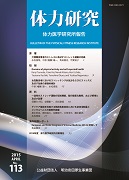All issues

Volume 117
Displaying 1-3 of 3 articles from this issue
- |<
- <
- 1
- >
- >|
-
Takashi Jindo, Mitsuru Makishima, Naruki Kitano, Kyosuke Wakaba, Yuko ...2019Volume 117 Pages 1-7
Published: 2019
Released on J-STAGE: October 23, 2019
RESEARCH REPORT / TECHNICAL REPORT FREE ACCESSInstallation of height-adjustable desks(HAD)are recommended to reduce sitting behaviors in the workplace. However, it is still unclear whether standing desk work using the HAD could decrease sitting time and increase physical activity(PA)during in-office working hours. This study aims to investigate the association of the usage of HADs with objectively measured sitting behaviors, or PA, among Japanese employees. This study was conducted in Tokyo in November 2018 at a single office of an office furniture manufacturing and sales company. Participants included 90 employees that completed a self-reported questionnaire survey and wore a tri-axial accelerometer to measure PA and sitting time(ST). In the target office, electric HADs were installed on hot-desking spaces, and fixed seats which were available for all employees. Participants were divided into two groups of users or non-users of HADs based on their responses to the questionnaire. Independent t-tests were applied to examine the differences in ST and PA between HAD users and non-users for participants stratified by job type(sales work or other office work). Among the office workers, users showed less ST and greater PA(ST: 377.4 ± 51.7, PA: 142.6 ± 51.7 min/8.67-hours)than non-users during working hours(ST: 412.0 ± 42.6, PA: 108.0 ± 42.6 min/8.67-hours), and greater non-locomotive activities(99.7 ± 45.1 min/8.67-hours)than non-users(67.1 ± 29.1 min/8.67-hours). HAD users showed fewer bouts of prolonged ST(consecutive ST for 30 minutes or longer)than non-users(1.2 ± 0.8 vs. 1.8 ± 0.6 time/8.67-hours). There were no significant differences observed between the two sales groups. These results suggest that working in a standing position using an HAD effectively improves ST in office workers. On the other hand, using an HAD might enhance non-locomotive activities, such as standing or posture adjust-ments at or around the desk, but it may not enhance locomotive activities.View full abstractDownload PDF (1048K) -
Kazuki Hyodo, Takashi Jindo, Kazuya Suwabe, Hideaki Soya, Toshiya Naga ...2019Volume 117 Pages 8-16
Published: 2019
Released on J-STAGE: October 23, 2019
RESEARCH REPORT / TECHNICAL REPORT FREE ACCESSAlthough a growing number of studies have reported the positive effects of acute aerobic exercise on mood and executive function in older adults, little is known about the effect of aerobic dance exercise(ADE)on executive function. In the present study, we aimed to compare the acute effects of light-intensity, slow-tempo ADE and light-intensity cycling exercise(CE)on mood and executive function in older adults. Twenty-one older adults performed each type of exercise for 10 minutes on separate days. The intensity of the CE was set at 60% of the ventilatory threshold. Before and after the exercise, mood(i.e., vitality, stability, pleasure, and arousal)and executive function were assessed by using the Two-Dimensional Mood Scale and the Stroop task, respectively. The heart rates and ratings of perceived exertion during exercise indicated that the intensities of both types of exercise were within the light-intensity range. Vitality and pleasure levels were increased following ADE, but no such changes were observed following CE. Although no differences in stability levels were observed following either type of exercise, we observed a significant interaction between time and exercise group, suggesting that there could be differences between the acute effects of ADE and CE. Unlike other psychological levels, the arousal level was increased to the same extent following both types of exercise. Stroop interference time, an indicator of executive function, was shortened to the same extent after both types of exercise. These findings suggest that ADE may represent an effective exercise modality for enhancing mood and executive function in older adults.View full abstractDownload PDF (1395K) -
Mizuki Sudo, Soichi Ando2019Volume 117 Pages 17-19
Published: 2019
Released on J-STAGE: October 23, 2019
RESEARCH REPORT / TECHNICAL REPORT FREE ACCESSDownload PDF (1016K)
- |<
- <
- 1
- >
- >|